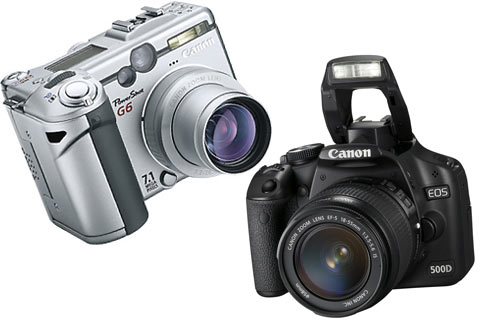
(Up to OJB's Photo Intro Page) CamerasI have used several different cameras (both conventional and digital) over the years I have been interested in photography, and although I have commented elsewhere that the camera isn't the most important part of the photographic process, I think I have changed my mind (at least on this web page). Maybe the photographer is most important, but the camera is vital too, for two main reasons... First, it must be capable of producing the image the photographer wants. If the result is blurry or overexposed, or deficient in some other way the photo is a failure. Second, the camera has to be easy to control. It should be an extension of the photographer. There's no point in having every fancy function on your camera if its too hard to use or too slow to activate. After using many brands I am convinced that Canon provide the best combination of quality images, ease of use, reliability, flexibility, and reasonable price. On previous cameras I either didn't have the functions I needed (for example my Sony didn't have an aperture priority program) or the functions were too hard to access (my early Nikon was a nightmare to use in manual focus mode). I now use a Canon digital SLR and its a really nice camera - its very flexible and it produces great images. It is just too big to take carry around everywhere so I also have several cheap compact cameras (which the rest of the family are also allowed to use!) which I carry everywhere. I have tried to compromise with high quality compact cameras in the past, but they just don't do the job like a dSLR can. My current camera is a Canon EOS 650D which was Canon's current mid level digital SLR (the 700D has now been released but is practically identical). Its an 18 megapixel camera, and I have several lenses to go with it: an 18-55 IS, a 35-80, and a 75-300, so I can cover a huge range without sacrificing image quality too much. My Canon film camera uses the same lenses, so I didn't need to buy new lenses when I got the digital. I bought the 650D to replace a Canon EOS 500D (a.k.a. Rebel T1i and Kiss X3) which is pictured at the top of this page. That, in turn, replaced a Canon EOS 350D which was an 8 megapixel camera, but lacked the live preview, extra pixels, movie mode, and many other features the latest cameras have. I did over 10,000 photos on that camera though and it still worked perfectly when I sold it so it was a really reliable workhorse. Advantages of dSLRsWhat is this flexibility I am talking about above? I often help people with more basic digital cameras, and I often find myself saying something like "normally I would use [insert any function here] to do this, but your camera doesn't have it, so try this instead." The sort of things I mention are: aperture priority programs, a decent manual focus function, or spot metering, amongst others. Why are these functions useful? I'll try to tell you why below... Aperture priority and shutter priority become useful in tricky conditions and when you want to produce a creative effect. For example, if you want to deliberately blur the background of a photo of a fast moving object, its nice to set the shutter speed you want (for example 1/10 second) and let the camera set the aperture to get the exposure right. That's what shutter priority does. Sometimes you want to get extra "depth of field". That's where close and distant objects are both in focus. To do this you want to set a narrow aperture (for example f/22) and let the camera set the shutter speed. That's what aperture priority does. Automatic focus works well most of the time, but in extreme situations, where there is very little contrast in the subject, or you want to focus on something that is not the most conspicuous object in the frame, then setting the focus manually is useful. Often fine tuning focus for macro photography can be useful too. Many cameras have a manual focus function which allows focussing to infinity, 20 meters, 5 meters, 1 meter, for example, this isn't really fine enough to be really useful. Spot metering is useful for photos where different elements are lit to widely varying amounts. For example, photographing a person against a bright background will often result in the person being under-exposed. Spot metering allows you to point at the object in the frame that is most important to you. That will expose the photo for that object, and over or under-expose the rest. Many cameras have automatic "artificial intelligence" functions which guess the right part(s) to expose on. These are often very good, but you can never be sure they will get it right. Its nice to be able to try them first, but then switch to spot metering if they fail. The big difference I found when moving to a dSLR was just the responsiveness of the camera. Its starts up in 0.2 of a second. The auto-focussing is fast and precise. The delay between pressing the button and the picture being taken is practically zero. It gives quality images even in low light and other awkward situations. If every shot was simple, the subject was at the right distance, well lit, stationary, and not too contrasty or smooth, a compact camera might be adequate. But for taking good photos in any situation, a more advanced camera is a must! ![[Up]](../XuShared/Up4B.jpeg)
Comment on this page: Useful • OK • Useless or: View Results |
||||||||||||